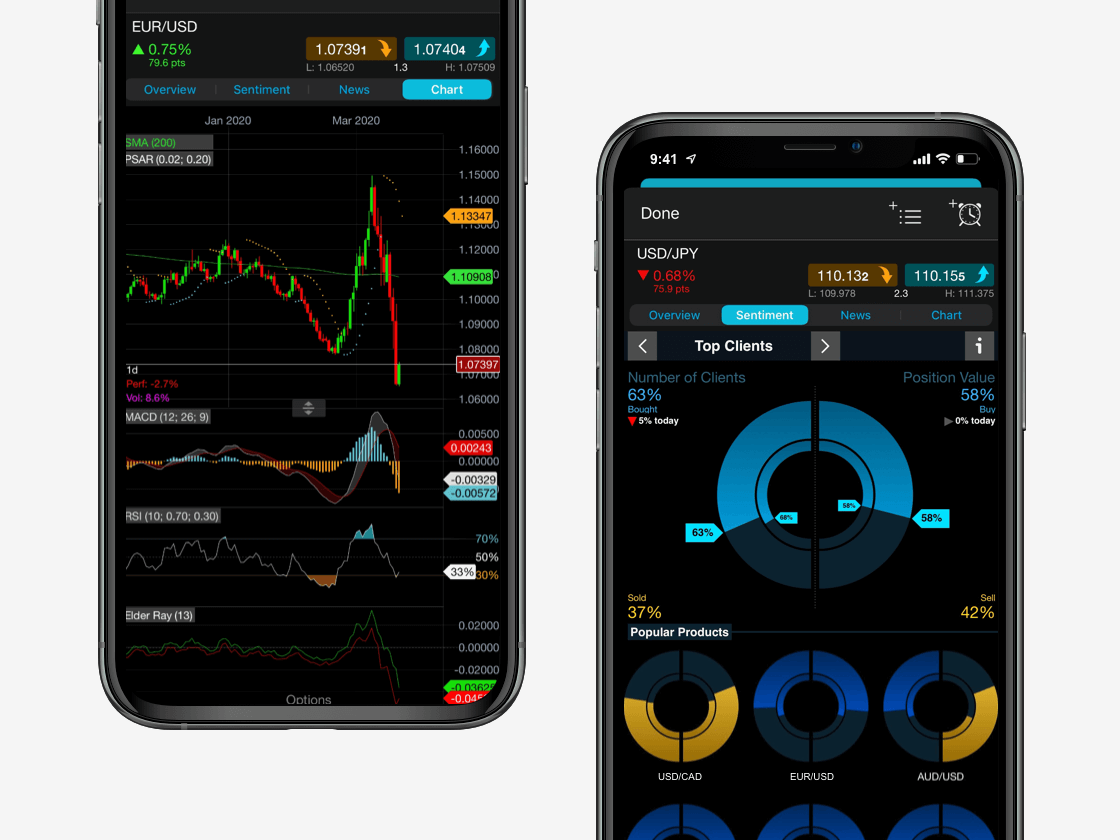
Shorting a stock in the UK
Many investors and traders profit from bull markets. They invest in companies they expect to grow based on optimistic views. However, some dealers attempt to profit from declining share prices, struggling businesses and market crashes. These dealers are known as “short sellers” and prefer to profit from negative market sentiments, such as a bear market.
There are various ways to short a stock. In this article, we investigate how to short a stock via leveraged trading, and key signals when deciding what stock to short. Shorting stocks is more complex than trading based on optimistic market attitudes. Therefore, it is important to understand how to get started short selling and the implications of doing so.

What does shorting a stock mean?
Most investors aim to benefit from stocks or shares that are forecasted to have the potential for future growth and development. However, short selling or shorting stocks is a trading technique that involves profiting from the decline of a company’s share price.
Traders who follow conventional trading strategies are usually looking for markets that are becoming more relevant or companies that are outperforming the market average. However, short-sellers do the opposite. They look for shares that are underperforming in the market or shares that could become less relevant in the near future.
How does shorting a stock work?
Unlike most traders who like to buy low and sell high, short-sellers adapt the order of this philosophy and aim to sell high and buy low. Short selling is a complex topic, and there are many things to be mindful of when shorting a stock. A stock can be shorted in two ways, with a traditional brokerage or a leveraged trading provider.
Traditional brokerage
When shorting a stock via a traditional broker, traders borrow shares they do not own. These shares are usually lent from their financial broker. The trader then sells the borrowed shares at market value. The trader aims to repurchase the same shares at a lower price and return the shares to the lender. If the price of the stock drops, short-sellers profit from the difference in price between the rate they borrowed at, and the rate they repurchased the shares.
This method does come with some caveats, but namely that it is up to the broker to decide if the share can be shorted. However, say that you can find a broker to lend you a stock to short, you will most likely have to pay borrowing fees as well as any dividends paid by the borrowed stock. Given the costs and the complexity of short selling, it is often recommended for experienced traders. There is, however, a more accessible way to short sell stocks known as leveraged trading.
Leveraged trading
When traders short sell via leveraged trading, they do not own the underlying stocks. Spread betting and CFD trading are two types of leveraged trading with many similarities and some unique differences. However, both products offer the trader an opportunity to take a ‘sell’ position on shares and profit from stock price downfalls without the need to borrow physical stocks. With leveraged trading, your profits and losses are magnified by your leverage ratio.
Spread betting
Spread betting is a popular form of leveraged trading which is available only in the U.K. and Ireland. Spread betting involves traders placing a bet on which direction they think the stock market will move. This method of leveraged trading provides an efficient method to short a stock without having to wait to borrow stock. Additionally, spread bet profits are commonly tax-free*. However, the spread is a key cost when shorting stocks via spread betting. View our competitive spreads across thousands of stocks and ETFs here.
CFD trading
CFD trading is an alternative to spread betting and is the most popular method of leveraged trading. CFD trading is available globally, providing an efficient method to short stocks from most countries. Similar to spread betting, CFD traders speculate whether they believe the market will fall or rise, receiving profit for correct speculations and incurring a loss for incorrect predictions.
Learn how to short-term trade with us.
How to short a stock
To short a stock with a spread betting or CFD trading account, you can follow these simple steps to get you started:
- Open a live CMC trading account. You can begin to short stocks with our spread betting or CFD leveraged trading accounts. See the differences between CFDs and spread betting if you are not sure which to choose. Our leveraged trading accounts are also available as a demo account in a risk-free environment for all customers.
- Find the right stock to short. Make use of our news and analysis section, to inform yourself of market turbulences that could precede stock crises. Also, see our fundamental analysis resources that could help you determine which companies are likely to struggle.
- Manage your risk. Before you place a trade, make sure you have adhered to suitable risk management strategy. Read more about managing your risk.
- Go 'short' and sell. Choose a position size in line with your trading strategy and place a 'sell's order ticket request to short-sell your chosen stock.
How to find stocks to short sell
Finding the right time to short a stock can be the difference between good and bad short selling. Generally, it is dependent on a trader’s strategy to find effective market entry and exit points. Our guide to stock market trading hours will also help you to determine the right time of day to place a trade. Most traders will use a combination of strategies to determine when they will enter the market, but it varies distinctly between technical analysts and fundamental analysts.
Technical analysis
Technical analysts could short a stock based upon what direction the general trend is heading. Using simple trend line indicators, technical analysts would analyse the trend direction of a share or stock. If the trend showed no signs of slowing down, it would present a key opportunity for technical analysts to ride the trend downwards.
Technical indicators such as the simple moving average (SMA) or exponential moving average (EMA) can provide key insight for technical analysts. Stocks that drop through prominent support points or fall below major moving averages (e.g. 200-day moving average) may continue on a descending trend.
Fundamental drivers
Missed earning reports present a big opportunity for short-sellers. If a company profit does not meet profit estimations, it is likely to be underperforming in certain areas. This could cause a large number of investors to start short selling. However, it is often best to look beyond just earning reports, as a company may be underperforming for reasons that do not impact its stock price.
Declining industries provide another opportunity for short-sellers. Industries that have experienced a general downtrend due to innovations in other markets or negative client sentiment can cause a particular stock’s price to plummet. This can also be affected by political and economic events such as presidential elections and trade wars. When an industry is perceived as obsolete, companies in that competitive space can be left with dwindling growth prospects, causing short sellers to take advantage.
Overvaluation is a common factor that can cause short sellers to come together. Stocks that are constantly covered in the news can cause the price to hyper-inflate relative to the stocks actual value. Once the stock market bubble bursts, short sellers will come together knowing that the stock is not worth its current market value.
However, please note that a stock’s fundamental values are not sole determinants of its price. There are various factors to consider when shorting a stock, and these factors form a complex picture. Each trader should do their own research when considering to trade stocks.
Trade on 9,000 stocks and ETFs with us
Example of short selling stocks
For example, let us say that you wanted to short US stock Apple (AAPL) via CFD trading.
Apple is currently trading @ $300.
You open a position to “sell” 10 share CFDs @ $300. Your total market exposure is now $3,000.
CFDs are leveraged, meaning you only need to pay a deposit of the full trade amount to open the trade. The margin rates for shares are 20%, meaning you have to deposit $3000 x 20% = $600 margin requirement.
A profitable trade
The market has fallen as you predicted. Apple is now worth $250.
You close your position with 10 share CFDs @ $250. You take away $2,500.
Your total trade value was $3,000, but it is now worth $2,500, a $500 profit*.
An unprofitable trade
The market has risen, opposite to your predictions. Apple is now worth $325.
You close your position with 10 share CFDs @ $325. You take away $3,250.
Your total trade value was $3,000, but it is now worth $3,250, a $250 loss*.

Benefits of shorting a stock
- Hedging risks. Using short selling to offset the risks of other assets in your portfolio is a known strategy for savvy long-term investors. Hedging your other positions by short selling can reduce your overall risk exposure. Say, for example, you purchased some shares in Google and intended to hold them for 10 years to profit from the companies expected growth. If any short-term disruptions impacted the rising trend of Google share price and it started to fall, you could hedge your investment position by short selling. This way, any losses that exist for Google's shares can be reduced by the profits of the short sell.
- Opportunity. Most financial markets are volatile and sensitive to external forces. Having the opportunity to take a position on both sides of the market can be more useful than only having access to buying opportunities.
- Market crashes and recessions. Short selling provides one of the few opportunities to profit from declining markets and recessions. Without having the ability to short a share, profit opportunities would be limited to periods of market growth.
Risks of shorting a stock
- Limited profit and unlimited loss. When shorting a stock through a broker the maximum profit you can make is limited as a stock cannot surpass being worthless. Additionally, losses can be hypothetically unlimited as there is no limit to a rising stock price. However, when leveraged trading, the use of stop-loss orders can be used to manage this risk.
- Short squeeze. When a group of short-sellers make an incorrect decision to short a stock, they can panic and sometimes buy back the stock they were shorting. This increase in market activity can cause buying pressure that pushes up stock prices. Losses are realised for short-sellers when the market turns in the opposite direction of what they suspected. This process is referred to as a short squeeze.

Practise shorting stocks on the go
Seamlessly open and close trades, track your progress and set up alerts
How to make money selling stocks short
Short selling can provide a great opportunity for many traders, as being able to play both sides of the market increases the chance of finding markets that match your trading strategies. Additionally, the ability to short a stock via a leveraged trading product provides a more streamlined process in comparison to conventional methods to short a stock.
When learning to short a stock, you must take into account the risks that arise with leveraged trading. Features such as guaranteed stop losses and negative balance protection can be particularly useful when attempting to mitigate your risk exposure. These features can provide a larger margin of error in comparison to conventional short selling. Visit our guide on risk management for more information.
View our article on undervalued stocks for more strategies that can be applied to trading stocks and shares.
*This does not consider the commission charges. When trading shares via CFDs a commission cost is incurred, read our article on CFD commissions for more information.

